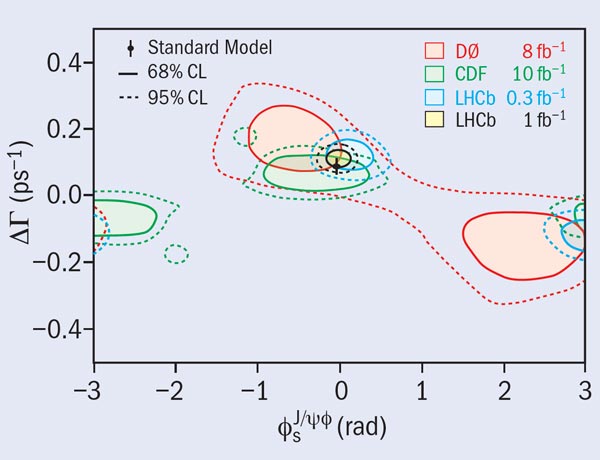
The LHCb collaboration has determined the sign of the width difference in the Bs system, ΔΓs, through the influence of quantum-mechanical interference. This shows for the first time that the heavier of the two Bs meson states has the longer lifetime, a result that is in agreement with the Standard Model expectation and similar to the situation in the kaon system.
The Bs meson, made up of a b quark and s antiquark, has some fascinating properties. Because it is neutral, it can mix with its antiparticle (which has a b antiquark and s quark), and this quantum-mechanical effect leads to the Bs system having two states with well defined mass, mH and mL (for “heavy” and “light” respectively). The Bs oscillates from its particle to antiparticle state, with a frequency that is proportional to the difference in those masses, Δms = mH – mL, a frequency that is now well measured. However, the two states are also expected to have different lifetimes, so that their widths (defined as the inverse of their lifetimes) should differ by ΔΓs ≡ ΓL – ΓH. Until now, the sign of ΔΓs was not known.

This parameter is intimately involved in the study of CP-violation in Bs mixing, where the phase of the Bs oscillations, φs, is measured. In the Standard Model, the phase is expected to be small but accurately predicted, φs = –0.036 ± 0.002 rad. It has been studied using the decays of the Bs to two lighter mesons, Bs → J/ψ φ. Because of correlations between ΔΓs and φs, the experimental searches have been presented until now as contours in the ΔΓs vs φs plane, as shown in the figure, which is an update of a previous measurement. However, because the sign of ΔΓs was unknown, there was an ambiguity in the solution, seen as two selected regions in the ΔΓs vs φs plane.
The new analysis from LHCb uses the fact that, when the spin-1 φ meson is reconstructed in its decay to K+K– , a small admixture of spin-0 kaon pairs is also included in the selected events, because – at any given K+K– mass value – the two possible spin states are quantum-mechanically indistinguishable, interference effects can be observed in the data. The relative phase of these two components varies as a function of the reconstructed mass and the trend of that variation is to increase or decrease depending on the sign of ΔΓs. The experimental data show clearly a decreasing trend, with 4.7 σ significance, demonstrating that ΔΓs is positive (LHCb 2012a). As a consequence, in the latest update of the CP-violation study there is only a single solution in the plane.
This new result was presented at the Moriond conference (Much food for thought at Moriond) and uses the full data set collected by LHCb so far (LHCb 2012b). When combined with another channel (J/ψ f0), the result is φs = –0.002 ± 0.083 (stat.) ± 0.027 (syst.) rad. While this is consistent with the Standard Model prediction, there is still room for contributions from new physics to this phase. Another exciting step forward is expected with the further doubling of the LHCb data set, expected this year.
Further reading
LHCb collaboration 2012a arXiv:1202.4717, submitted to Phys. Rev. Lett.
LHCb collaboration 2012b LHCB-CONF-2012–002.








